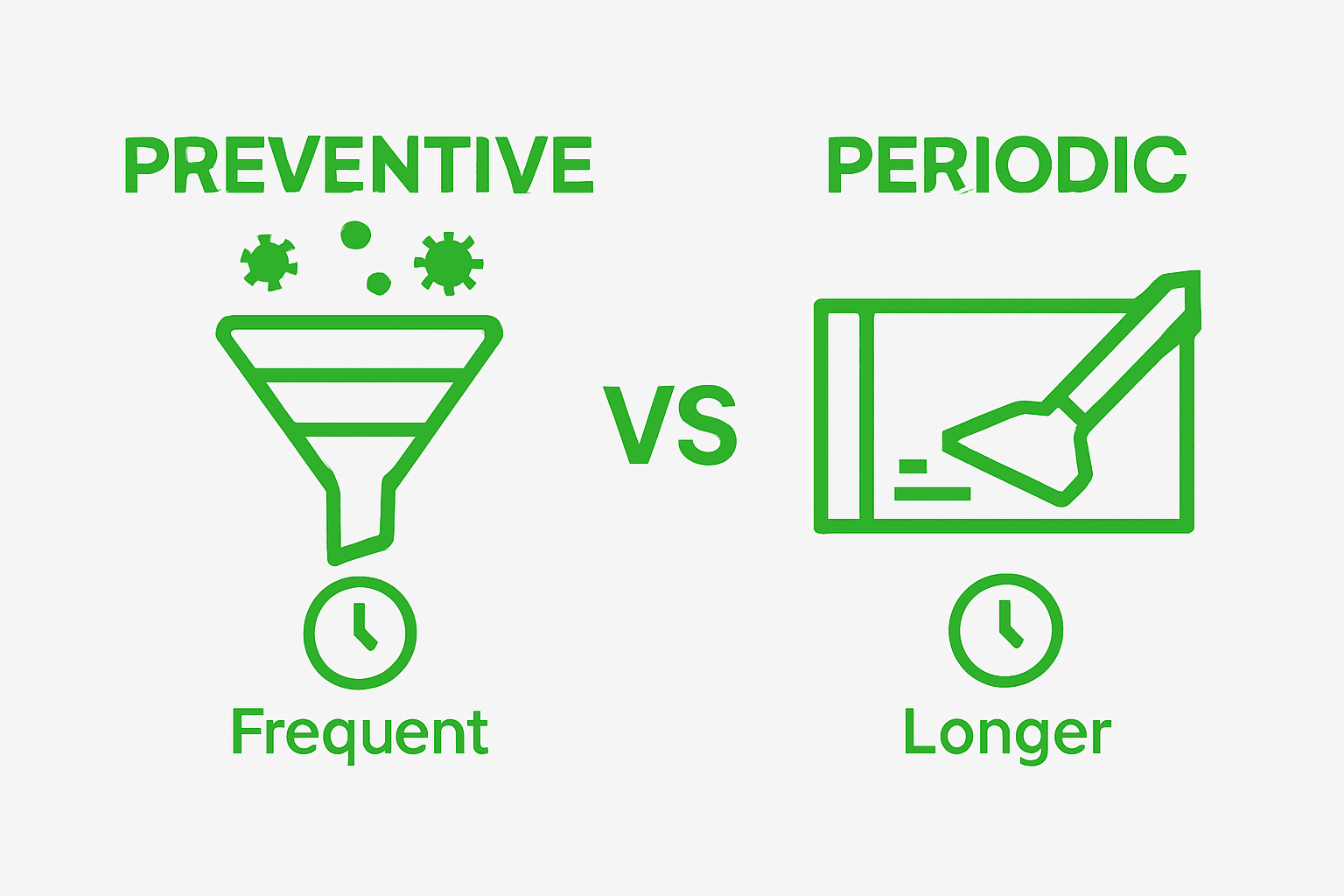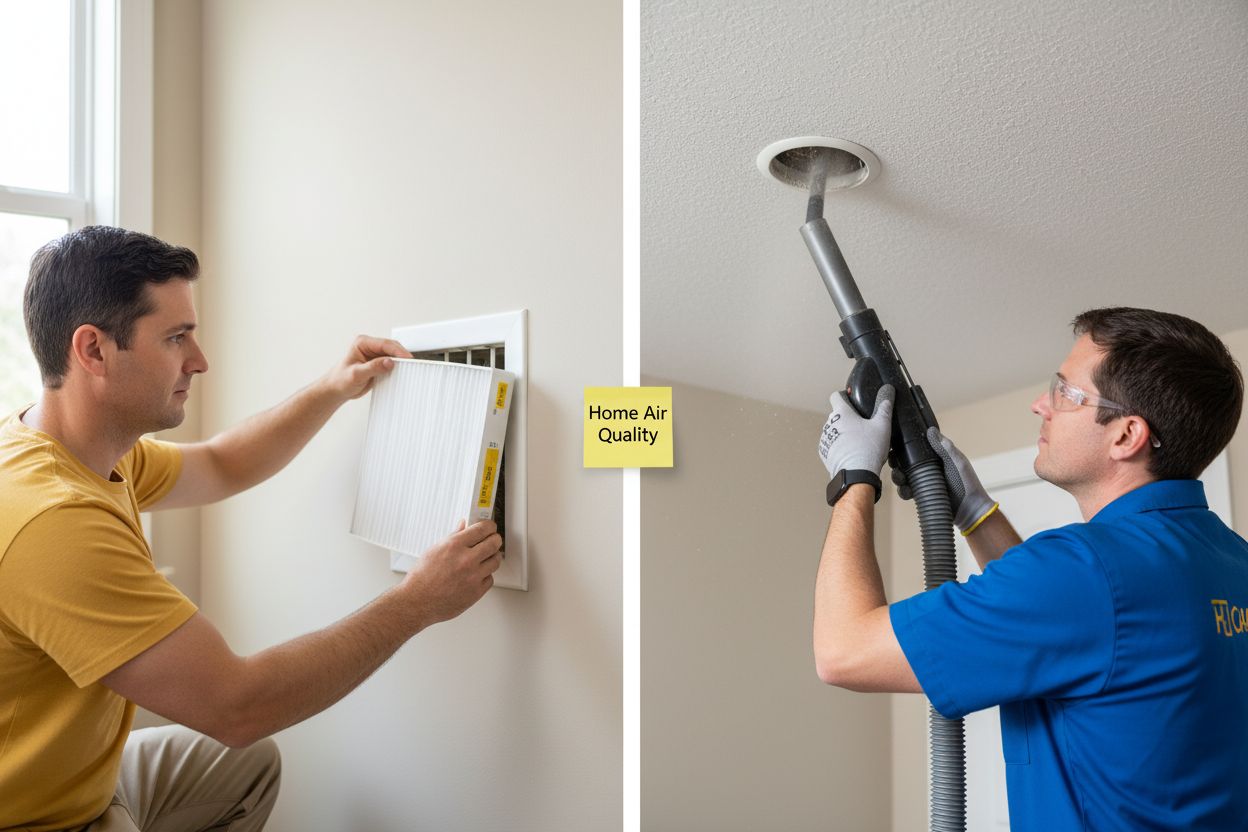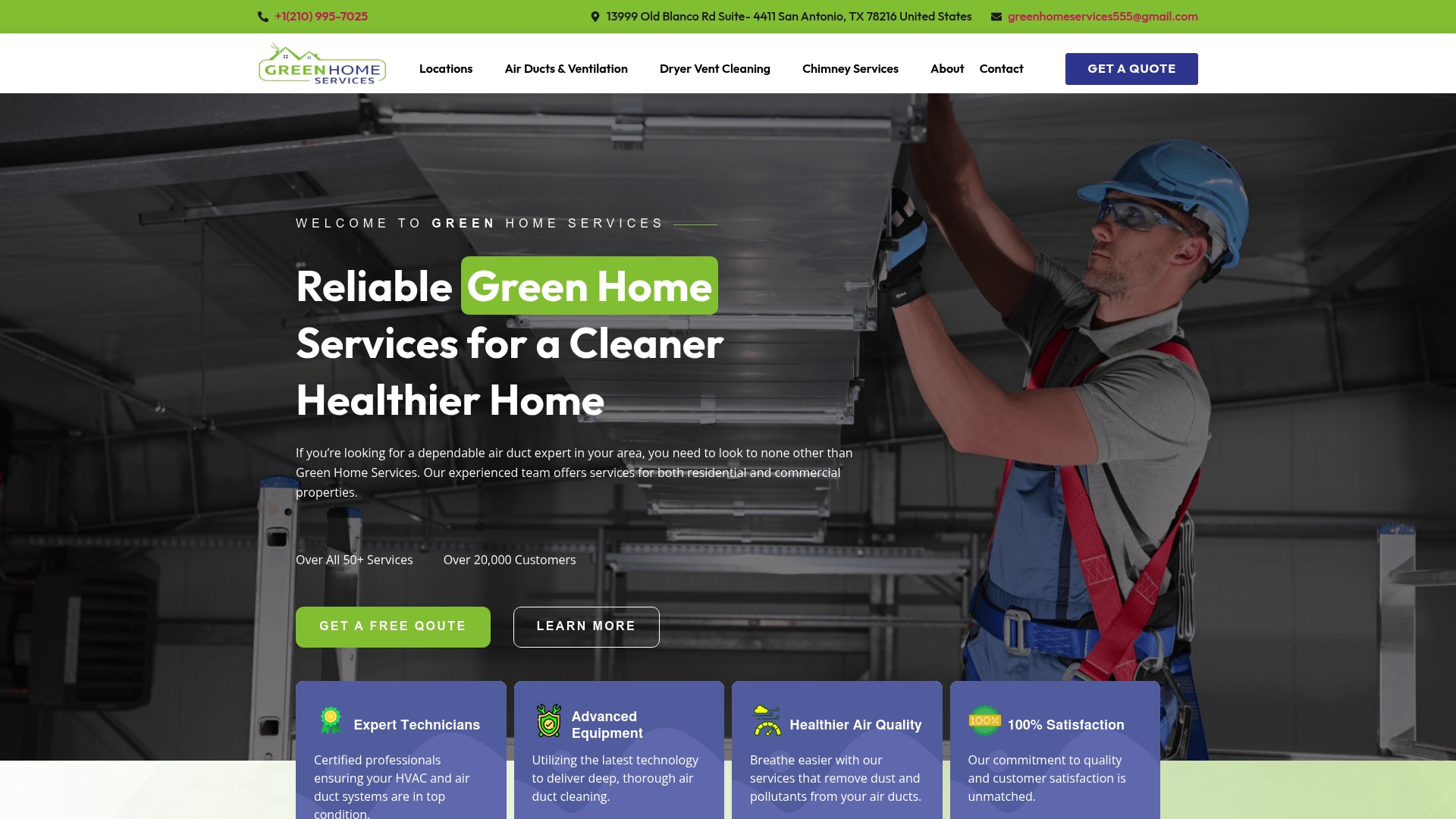Most people picture duct cleaning as just another household chore, but dust and allergens inside your vents are sneakier than you think. Believe it or not, HEPA filters can capture up to 99.97 percent of particles as small as 0.3 microns, yet no air filter can remove everything lurking deep inside ductwork. The catch is that filters work around the clock but only duct cleaning reaches the hidden buildup that even the best filters miss.
Table of Contents
- What Is Duct Cleaning And How Does It Work?
- Understanding Air Filters: Types And Functions
- Why Duct Cleaning Matters For Homeowners
- The Role Of Air Filters In Indoor Air Quality
- Comparing Duct Cleaning And Air Filters: Key Differences
Quick Summary
| Takeaway | Explanation |
|---|---|
| Regular duct cleaning enhances air quality. | Cleaning removes allergens and contaminants, improving indoor air quality and reducing respiratory issues. |
| Air filters require frequent replacement. | Change filters every three months to maintain HVAC efficiency and ensure clean airflow throughout your home. |
| Duct cleaning is vital for specific conditions. | Homes with pets or recent renovations may need duct cleaning to prevent contaminated air circulation. |
| HEPA filters capture 99.97% of particles. | Using HEPA filters significantly improves air quality by trapping nearly all airborne particles 0.3 microns or larger. |
| Duct cleaning improves HVAC efficiency. | Regular cleaning reduces debris build-up, leading to lower energy costs and prolonging equipment lifespan. |
What is Duct Cleaning and How Does It Work?
Duct cleaning represents a comprehensive process of removing accumulated dust, debris, allergens, and potential contaminants from your home’s heating, ventilation, and air conditioning (HVAC) system. Professional duct cleaning services involve a systematic approach to improving indoor air quality and system efficiency.
The Mechanics of Professional Duct Cleaning
The process begins with a thorough inspection of your home’s entire air duct network. Trained technicians use specialized equipment like high-powered vacuum systems and rotating brushes to dislodge and remove accumulated particles. These tools are designed to access hard-to-reach areas within the ductwork, ensuring a comprehensive cleaning that goes beyond surface-level maintenance.
Specifically, the cleaning process typically involves:
- Disconnecting the air handler and creating negative pressure using powerful vacuum equipment
- Dislodging contaminants using specialized brushes and compressed air tools
- Cleaning individual components including supply and return air ducts, registers, grilles, and diffusers
Why Duct Cleaning Matters for Home Air Quality
While not always necessary for every home, duct cleaning becomes crucial in certain scenarios. Read more about why air ducts get dirty to understand the potential accumulation of pollutants. Homes with pets, recent renovations, residents with respiratory conditions, or those in areas with high dust levels can particularly benefit from professional duct cleaning.
The goal is not just cleaning, but creating an environment where your HVAC system operates at peak efficiency, potentially reducing energy consumption and improving overall air circulation. By removing built-up debris, homeowners can experience enhanced indoor air quality, reduced allergen circulation, and more consistent temperature regulation throughout their living spaces.
Understanding Air Filters: Types and Functions
Air filters serve as critical components in maintaining indoor air quality and protecting HVAC systems from potential damage. According to the Environmental Protection Agency, these devices play a fundamental role in trapping airborne particles and improving overall air circulation within residential spaces.
Types of Air Filters
Multiple air filter designs exist, each with unique characteristics and filtration capabilities. The most common types include mechanical filters, electrostatic filters, and activated carbon filters. Mechanical filters, such as High-Efficiency Particulate Air (HEPA) filters, physically trap microscopic particles using dense fiber materials. Electrostatic filters utilize electrical charges to attract and capture dust and allergens, while activated carbon filters excel at removing odors and chemical pollutants.
Key air filter categories include:
- Fiberglass filters: Economical and disposable, providing basic particle filtration
- Pleated filters: Increased surface area for better particle capture
- HEPA filters: Advanced filtration capturing 99.97% of particles 0.3 microns or larger
- Washable filters: Reusable options that can be cleaned and reinstalled
Function and Importance of Air Filters
Our comprehensive guide on understanding HVAC systems highlights the critical role air filters play in system performance. Beyond trapping dust and allergens, these components protect HVAC equipment from debris accumulation, which can cause mechanical strain and reduced efficiency. Regular filter maintenance ensures optimal airflow, lower energy consumption, and improved indoor air quality.
Homeowners should consider factors like filter efficiency ratings (MERV), replacement frequency, and specific household needs when selecting air filtration solutions. A well-chosen air filter not only preserves HVAC system health but also creates a cleaner, more comfortable living environment.
To clarify the main types of air filters and their distinguishing features, the following table organizes key filter categories discussed in the article and summarizes their core characteristics.
| Air Filter Type | Description | Key Benefit |
|---|---|---|
| Fiberglass | Basic, disposable filter made of layered fiberglass | Economical option for basic dust filtration |
| Pleated | Folded material with increased surface area | Improved particle capture over fiberglass |
| HEPA | Dense fibers, captures 99.97% of 0.3 micron particles | Highest particle removal efficiency |
| Electrostatic | Attracts particles using static electricity | Captures dust and allergens efficiently |
| Activated Carbon | Uses carbon to absorb odors and chemicals | Removes odors and chemical pollutants |
| Washable | Reusable; can be cleaned and reinstalled | Cost-effective and environmentally friendly |
Why Duct Cleaning Matters for Homeowners
According to the Environmental Protection Agency, duct cleaning becomes crucial when specific conditions compromise indoor air quality and HVAC system performance. While not universally necessary, strategic duct maintenance can significantly impact home comfort and respiratory health.
Health and Air Quality Implications
Dirty air ducts can become breeding grounds for multiple contaminants that directly affect household health. Accumulated dust, pet dander, pollen, and potential mold spores circulate through your living spaces when HVAC systems operate, potentially triggering allergies, respiratory issues, and other health complications. Individuals with asthma, allergies, or compromised immune systems are particularly vulnerable to these environmental pollutants.
Key health risks associated with neglected ductwork include:
- Increased allergen circulation throughout living spaces
- Potential respiratory irritation and inflammatory responses
- Higher risk of mold and bacterial growth
- Reduced overall indoor air quality
HVAC System Performance and Efficiency
Learn more about the long-term benefits for Texas homeowners, clean ductwork significantly impacts your HVAC system’s operational efficiency. Accumulated debris forces heating and cooling systems to work harder, consuming more energy and potentially shortening equipment lifespan. Regular duct maintenance helps maintain optimal airflow, reduces mechanical strain, and can lead to noticeable reductions in monthly energy expenditures.
Homeowners should recognize that professional duct cleaning is not just about removing visible dust. It represents a comprehensive approach to maintaining a healthy, efficient home environment. By addressing potential contaminant buildup proactively, you protect both your family’s health and your significant HVAC system investment.
The Role of Air Filters in Indoor Air Quality
According to the Environmental Protection Agency, high-efficiency air filters play a crucial role in capturing microscopic particles and improving overall indoor environmental health. These critical components serve as the first line of defense against airborne contaminants that can compromise respiratory wellness and household comfort.
Particle Filtration and Contaminant Removal
Air filters operate as sophisticated screening mechanisms designed to intercept various particulate matter circulating through HVAC systems. Microscopic particles like dust, pollen, pet dander, and potential allergens are systematically trapped before they can disperse throughout living spaces. The filtering process depends on multiple factors, including filter material density, electrostatic properties, and mechanical design.
Key contaminants effectively captured by advanced air filters include:
- Dust mites and their waste products
- Microscopic skin cells
- Pollen from outdoor environments
- Pet dander and hair
- Textile and carpet fibers
- Mold spores
Performance and Efficiency Considerations
Learn more about how dust impacts HVAC systems, air filter effectiveness is measured through standardized Minimum Efficiency Reporting Value (MERV) ratings. These ratings range from 1 to 20, with higher numbers indicating superior particle capture capabilities. Residential systems typically utilize filters with MERV ratings between 8 and 13, balancing filtration performance with airflow maintenance.
Homeowners should understand that air filters represent more than simple mechanical barriers. They are sophisticated environmental guardians working continuously to protect respiratory health, maintain HVAC system efficiency, and create cleaner indoor living environments. Regular filter maintenance and strategic selection based on specific household needs remain critical for optimal performance.
Comparing Duct Cleaning and Air Filters: Key Differences
According to the Environmental Protection Agency, duct cleaning and air filters serve complementary yet distinctly different roles in maintaining indoor air quality. Understanding their unique functions helps homeowners develop more comprehensive strategies for managing their home’s respiratory environment.
Functional Approaches to Air Quality
Air filters function as continuous, proactive defense mechanisms that trap airborne particles during regular HVAC system operation. These components work in real-time, capturing microscopic contaminants before they can circulate through living spaces. In contrast, duct cleaning represents a periodic, comprehensive intervention targeting accumulated debris within the entire ductwork system.
Key operational differences include:

- Air filters: Continuous particle interception
- Duct cleaning: Periodic deep system cleaning
- Air filters: Preventative maintenance
- Duct cleaning: Remedial maintenance strategy
Frequency and Maintenance Requirements
Learn more about understanding the difference between AC and duct cleaning, air filters demand more frequent attention. Homeowners typically replace filters every three months, while professional duct cleaning might occur every three to five years. The frequency depends on specific household conditions such as pet ownership, renovation activities, and overall indoor air quality challenges.
Ultimately, both approaches contribute to a holistic indoor air quality management strategy.
To better understand the core distinctions between duct cleaning and air filters, the following comparison table highlights their roles, maintenance frequency, and impacts on air quality as discussed in the article.
| Feature | Duct Cleaning | Air Filters |
|---|---|---|
| Primary Function | Periodic deep cleaning of ductwork | Continuous trapping of airborne particles |
| Maintenance Frequency | Every 3-5 years | Replace every 3 months (typically) |
| Immediate Impact | Removes built-up contaminants | Prevents real-time circulation of pollutants |
| Targeted Issues | Accumulated dust, debris, mold | Everyday dust, pollen, pet dander |
| Impact on HVAC Efficiency | Improves by eliminating blockage | Maintains by allowing optimal airflow |
| Health/Allergen Control | Reduces long-term exposure | Reduces daily exposure |
| Best For | Homes with recent renovations, pets | All households, especially allergy sufferers |
Air filters provide continuous protection, while duct cleaning addresses deeper, long-term contamination issues. Homeowners benefit most when these methods are viewed as complementary rather than competing approaches to maintaining a healthy indoor environment.

Ready for Cleaner Air? Discover the Green Home Difference
Do you ever wonder why your indoor air quality just does not improve enough, no matter how often you change your air filters? The real problem may go deeper than surface solutions. As explained in this article, dust, allergens, and mold can build up inside your ductwork and keep coming back, even after replacing filters. This ongoing struggle for fresh air can leave your family vulnerable to allergies, asthma, or recurring dust buildup, all while your HVAC system works overtime and your bills rise. Understanding the actual effectiveness of duct cleaning versus air filter maintenance is the first step toward solving the problem for good. For more insights into related topics, you can also explore our Uncategorized resources.

Choose Green Home Duct Cleaning as your trusted team in San Antonio or Austin. We use advanced equipment and eco-friendly cleaning methods to help you experience true comfort, cleaner air, and peace of mind. Take control of your home environment now—visit our main site to book a professional duct cleaning or learn more about our personalized solutions that go beyond simple filter changes.
Frequently Asked Questions
What is duct cleaning and why is it important?
Duct cleaning is the process of removing dust, debris, allergens, and contaminants from your HVAC system. It is important because it improves indoor air quality, enhances system efficiency, and can prevent health issues related to poor air circulation.
How often should I have my air ducts cleaned?
Typically, air ducts should be cleaned every three to five years, but frequency can vary based on factors like pet ownership, recent renovations, or respiratory health concerns in the household.
What are the differences between duct cleaning and air filters?
Duct cleaning is a periodic deep cleaning of the ductwork, while air filters offer continuous, real-time protection by trapping airborne particles during HVAC operation. Both are crucial for maintaining indoor air quality but serve different functions.
How do I know if my air filter needs to be replaced?
You should replace your air filter every three months, but if you notice increased dust in your home, reduced airflow, or if the filter appears visibly dirty or clogged, it’s time for a replacement.
Recommended
- Air Duct Cleaning Basics: Essential Tips for Texas Homes 2025 – Green Home Services
- Understanding Why Air Ducts Get Dirty in Your Home – Green Home Services
- Choosing a Duct Cleaning Company: Texas Homeowner Guide 2025 – Green Home Services
- Duct Cleaning Frequency in Texas: 2025 Guide for Homeowners – Green Home Services
